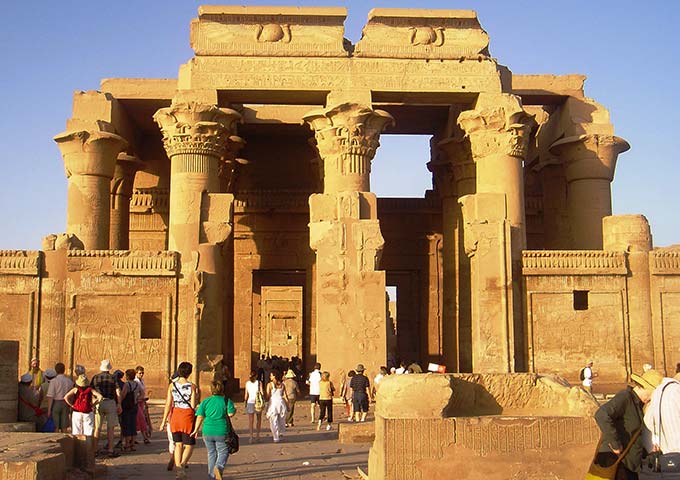The town of Komombo is located 30 miles north (or downstream) from the city of Aswan. Most people visit the temple from either a cruise or a felucca boat.
Many of the Nubians displaced by Lake Nasser and the building of the High Dam have now settled here. In ancient times the town stood at the crossroads of the caravan route from Nubia and trails from the gold mines of the Eastern Desert. It was also a training camp for African war elephants during the reign of Ptolemies.
While Modern day Komombo is known to the local workers for its sugar refinery and felucca building yards, tourists arrive in the town to visit the Temple of Haroeris and Sobek. The stone here differs from other sites because it was covered in sand for so long.
The Temple known as Komombo – actually two temples consisting of a Temple to Sobek and a Temple of Haroeris – stands on a low promontory near a bend in the river Nile. The Temple has been affected in many ways over the years, firstly due to the ever changing Nile, then the Copts who once used it as a church, and finally by builders who used the stones for new buildings.
Everything at the site is duplicated along the main axis. There are two entrances, two courts, two colonnades, two hypostyle halls and two sanctuaries. There were probably even two sets of priests. The left, or northern side is dedicated to Haroeris (sometimes called Harer, Horus the Elder) who was the falcon headed sky god and the right to Sobek (the crocodile headed god). In ancient times, sacred crocodiles basked in the sun on the river bank near here and mummified crocodiles can still be seen towards the right of the Temple.
The only thing left of the original Pylon is the foundations. Beyond the Pylon, there was once a staircase in the court that led to a roof terrace. The court has a columned portico and central altar. There is a scene of the King leaving his palace escorted by standards. Near the sanctuary is a purification scene. On either side of the door to the pronaos are columns inscribed with icons of the lotus (south) and papyrus (north), symbolizing the ‘two lands’ of Egypt.
In the southwest corner of the pronaos is the one column that does not echo the duality of the temples. Here, there are scenes depicting the purification of the King, his coronation and his consecration of the Temple. The ceiling here has astronomical images.
The hypostyle hall has papyrus capitals on the columns, along with an inventory of the scared places of Egypt, the gods of the main towns and the local and national festivals.
In the anti chamber, there are scenes depicting the goddess Seshat launching the building of the temple, followed by a scene of the completed temple with the king taking part in a purification ceremony. The staircase leading to the roof is all that remains of the offering hall.













